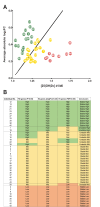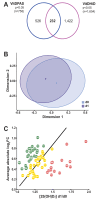Transcriptomic profiling of immune modulation induced by vitamin D3 in the VitDPAS and VitDHiD cohort studies
- PMID: 40389645
- PMCID: PMC12089289
- DOI: 10.1038/s41598-025-02495-w
Transcriptomic profiling of immune modulation induced by vitamin D3 in the VitDPAS and VitDHiD cohort studies
Abstract
The VitDPAS study (NCT06104111) was designed as a medical experiment to assess the in vivo effects of vitamin D on immune responses. This study enrolled 45 healthy individuals from Olsztyn, Poland, who received a body weight-adjusted bolus dose of vitamin D3 (1,000 IU/kg). Transcriptome-wide differential gene expression analysis of peripheral blood mononuclear cells, collected before and 24 h after supplementation, identified 758 significantly responsive genes (p < 0.05). By correlating individual gene expression changes with alterations in vitamin D status, participants were categorized into three response groups: 17 high responders, 19 mid responders, and 9 low responders. A comparative analysis with the VitDHiD study (NCT03537027), conducted on a Finnish cohort of 25 healthy participants, revealed 232 overlapping target genes, enabling an integrated assessment of vitamin D responsiveness across all 70 individuals. Applying a more stringent statistical threshold (false discovery rate < 0.05) highlighted 26 shared target genes, demonstrating a consistent in vivo response to vitamin D3 across both cohorts. The modulation of inflammatory processes, mediated primarily via tumor necrosis factor and nuclear factor κB signaling pathways, emerged as a shared effect, highlightening the immunomodulatory potential of vitamin D as a key function of the vitamin in healthy individuals.
Keywords: Inflammatory response; Transcriptome; Vitamin D; Vitamin D intervention studies; Vitamin D response index; Vitamin D target genes.
© 2025. The Author(s).
Conflict of interest statement
Declarations. Competing interests: The authors declare no competing interests.
Figures




Similar articles
-
In vivo vitamin D targets reveal the upregulation of focal adhesion-related genes in primary immune cells of healthy individuals.Sci Rep. 2024 Jul 30;14(1):17552. doi: 10.1038/s41598-024-68741-9. Sci Rep. 2024. PMID: 39080417 Free PMC article.
-
In vivo vitamin D target genes interconnect key signaling pathways of innate immunity.PLoS One. 2024 Jul 23;19(7):e0306426. doi: 10.1371/journal.pone.0306426. eCollection 2024. PLoS One. 2024. PMID: 39042613 Free PMC article.
-
Primary vitamin D target genes allow a categorization of possible benefits of vitamin D₃ supplementation.PLoS One. 2013 Jul 29;8(7):e71042. doi: 10.1371/journal.pone.0071042. Print 2013. PLoS One. 2013. PMID: 23923049 Free PMC article.
-
Intervention Approaches in Studying the Response to Vitamin D3 Supplementation.Nutrients. 2023 Jul 29;15(15):3382. doi: 10.3390/nu15153382. Nutrients. 2023. PMID: 37571318 Free PMC article. Review.
-
Oral vitamin D3 supplementation increases serum fibroblast growth factor 23 concentration in vitamin D-deficient patients: a systematic review and meta-analysis.Osteoporos Int. 2019 Nov;30(11):2183-2193. doi: 10.1007/s00198-019-05102-7. Epub 2019 Aug 1. Osteoporos Int. 2019. PMID: 31372708
References
-
- Holick, M. F., MacLaughlin, J. A. & Doppelt, S. H. Regulation of cutaneous previtamin D3 photosynthesis in man: skin pigment is not an essential regulator. Science211, 590–593. 10.1126/science.6256855 (1981). - PubMed
Publication types
MeSH terms
Substances
Grants and funding
LinkOut - more resources
Full Text Sources

